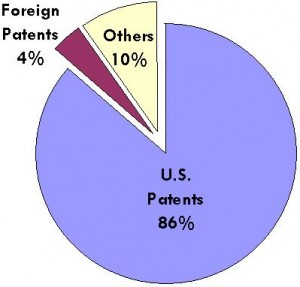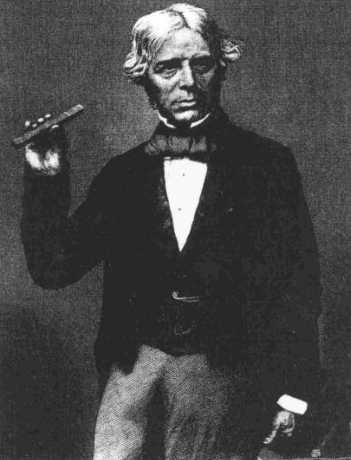As noted previously on ÆtherCzar, the FCC recently issued an NPRM proposing to offer favorable treatment to academic researchers over researchers in industry. Yesterday, ÆtherCzar presented evidence from wide-ranging studies showing that industry, not academia is the principal fountainhead of innovation. This previous research did not specifically address wireless technology, however. Today ÆtherCzar continues excerpting from a Comment I filed with the FCC last week – taking a closer look at the relative roles of industry and academia in one of the wireless industry’s most important and rapidly growing sectors: Radio Frequency Identification or RFID.
Some of the innovative wireless technologies the Commission has in mind in revising the Experimental Radio Service (ERS) – technologies like software-defined radios, and broadband radio technology – are still in relative infancy. This makes it difficult to assess whose contributions are most important to their yet-to-be-realized economic success. Instead, this comment focuses on the more mature Radio Frequency Identification (RFID) industry. RFID technology is an prime example of a recent wireless technology that has advanced to the point where clear technical winners are identifiable. This post examines the ten most frequently cited RFID patents to review the affiliations of the inventors behind these wireless success stories and the sources on which they relied for their innovations.
The realm of Radio Frequency Identification (RFID) offers a closely analogous case study for understanding the relative importance of academic versus industrial research. The RFID industry has matured to become a large and growing industry. ABI Research estimated the RFID market will total $5.35B in 2010 with growth to $8.25B by 2014.[1]

A recent study surveys 3,952 RFID patents from 1983 to February 12, 2008. [2] Of the top twenty assignees by patent issued, all are industrial concerns, and none are academic institutions.[3] Of the top ten RFID inventors, all are affiliated with industrial concerns, and none are academicians.[4] Of the top ten most cited RFID patents, three were from Micron Technologies, two from IBM, one each from Intermec, Lucent, Checkpoint Systems, Texas Instruments, and E-Tag Systems Inc. – again, no academic institutions. [5]
The inventors of each of the most significant RFID inventions relied on a certain body of pre-existing science and technology on which they built their invention. These inventors had not only a moral, but also a legal obligation to provide a full-disclosure of the closest, most relevant prior art.[6] The prior art associated with the ten most cited RFID patents was overwhelmingly other patents: 86% U.S. patents and 4% foreign patents. Of the remaining 10% of sources cited, most were trade journals and newspapers. Only about 3% were academic publications. Following is a table of the most cited RFID patents:
| Citations | Patent | Inventors | Assignee |
| 138 | 5649296 | John Austin MacLellan et al | Lucent |
| 130 | 5448110 | John R. Tuttle et al | Micron |
| 125 | 5963134 | John H. Bowers | Checkpoint |
| 109 | 5629981 | Virupax M. Nerlikar | Texas Instruments |
| 96 | 5550547 | Shun S. Chan et al | IBM |
| 92 | 5936527 | Marvin Isaacman et al | E-Tag System |
| 91 | 5682143 | Michael John Brady et al | IBM |
| 86 | 6100804 | Michael John Brady et al | IBM |
| 83 | 5497140 | John R. Tuttle | Micron |
| 80 | 5365551 | Charles K. Snodgrass | Micron |
As is usual in the development of a new technology, there are multiple contenders for the title of inventor of RFID. In 1973 Mario W. Cardullo was co-inventor on a patent[7] describing the first RFID system employing digital memory – the ancestor of modern RFID.[8] Mike Davis argues[9] that the honor should go to John R. Wiegand who first invented a digital read/write proximity RFID system.[10] In either case, the fundamental innovations underlying RFID were due to entrepreneurial researchers at relatively small businesses while larger, better capitalized businesses undertook the job of perfecting, improving, and applying RFID in larger scale deployments.
Previously on ÆtherCzar… Two different perspectives on the history of RFID from Michael L. Davis at DefCon 17 and from SoftwareHelpOnline.
UPDATE See also, more from ÆtherCzar:
- FCC Overhauls Experimental Licensing to Favor Academia Over Industry
- Academic Science and the Origins of Technology
- Who Invented RFID: Industry or Academia?
- Wireless Innovation by Small Businesses
And some additional links:
- The FCC’s NPRM to reform the Experimental Radio Service.
- My Comment filed with the FCC last week.
- CommLaw Blog: FCC Sets Out To Overhaul Experimental Licensing
- Steven J. Crowley: “Trusted” Academia Favored over Industry in FCC’s Proposed Experimental Rules
[1] See: http://www.abiresearch.com/press/1618-RFID+Market+to+Reach+$5.35+Billion+This+Year
[2] Shilpa Govada, Shirish Kandekar, Rachana Pejaver, John Wahlman, “Patent Analysis of RFID Technology, 9 May 2008. See: http://ai.arizona.edu/mis480/sample_projects/2008%20Spring/Patent%20Analysis%20of%20RFID%20Technology/KM%20RFID%20Report.pdf
[3] Ibid. p. 6.
[4] Ibid. p. 8.
[5] Ibid. p. 9.
[6] U.S.P.T.O Manual of Patent Examiner Practice §1.56 “Duty to disclose information material to patentability.”
[7] Mario Cardullo and William L. Parks, III, “Transponder apparatus and system,” U.S. Patent 3,713,148, January 23, 1973.
[8] Mario Cardullo, “Genesis of the Versatile RFID Tag,” RFID Journal. See: http://www.rfidjournal.com/article/view/392
[9] Michael L. Davis, “Wiegand’s Wonderful Wires,” DEFCON 17, June 30, 2009. See: http://www.defcon.org/images/defcon-17/dc-17-presentations/defcon-17-mike_davis_who_invented_the_proximity_card.pdf
[10] J. R. Wiegand, “Interceptor transformer proximity key,” U.S. Patent 3,448,440, June 3, 1969.


One thought on “Who Invented RFID: Industry or Academia?”